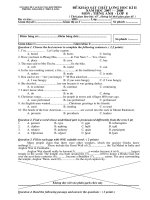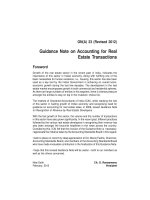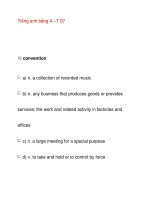A 391 a 391m 07 (2012)
Bạn đang xem bản rút gọn của tài liệu. Xem và tải ngay bản đầy đủ của tài liệu tại đây (85.7 KB, 4 trang )
Designation: A391/A391M − 07 (Reapproved 2012)
Standard Specification for
Grade 80 Alloy Steel Chain1
This standard is issued under the fixed designation A391/A391M; the number immediately following the designation indicates the year
of original adoption or, in the case of revision, the year of last revision. A number in parentheses indicates the year of last reapproval.
A superscript epsilon (´) indicates an editorial change since the last revision or reapproval.
3.1.2 date code, n—series of letters, numbers, or both,
embossed on the chain which enables its manufacturing history
to be traced.
3.1.3 lot, n—for the purpose of acceptance testing, a lot shall
consist of 3000 ft [1000 m], or fraction thereof, of the same
grade and size chain. If a continuous length of chain exceeds
3000 ft [1000 m], it shall also be considered a lot.
3.1.4 proof test, n—quality control tensile test applied to
chain for the purpose of verifying weld and material quality.
3.1.4.1 Discussion—It is the minimum force in pounds or
newtons which the chain has withstood at the time it left the
producer, under a test in which a constantly increasing force
has been applied in direct tension to a straight length of chain.
Proof test loads are a manufacturing integrity test and shall not
be used as criteria for service or design purposes.
3.1.5 traceability code, n—series of letters, numbers, or
both, embossed on the chain which enables its manufacturing
history, including the identity of the steel heat, to be traced.
3.1.6 working load limit (WLL), n—maximum combined
static and dynamic load in pounds or kilograms that shall be
applied in direct tension to an undamaged straight length of
chain.
1. Scope*
1.1 This specification covers Grade 80 heat-treated alloy
steel chain for such applications as slings, lifting assemblies,
and load binding.
NOTE 1—This specification does not cover alloy steel chain for pocket
wheel applications.
1.2 The Grade designation is 1⁄10 of the minimum breaking
strength in newtons divided by two times the nominal crosssectional area of the chain in square millimetres.
1.3 The values stated in either SI units or in other units shall
be regarded separately as standard. The values stated in each
system may not be exact equivalents; therefore, each system
must be used independently of the other, without combining
values in any way.
2. Referenced Documents
2.1 ASTM Standards:2
A29/A29M Specification for Steel Bars, Carbon and Alloy,
Hot-Wrought, General Requirements for
A751 Test Methods, Practices, and Terminology for Chemical Analysis of Steel Products
A941 Terminology Relating to Steel, Stainless Steel, Related
Alloys, and Ferroalloys
4. Ordering Information
4.1 It shall be the responsibility of the purchaser to specify
all requirements that are necessary for material ordered under
this specification. Such requirements to be considered include,
but are not limited to, the following:
4.1.1 Product to conform to Specification A391 or A391M
and year of issue,
4.1.2 Nominal size of chain in in. [mm],
4.1.3 Quantity of chain in ft [m],
4.1.4 Length of each piece, if required,
4.1.5 Finish, if required,
4.1.6 Certification of test(s), if required, and
4.1.7 Acceptance of inspection by purchaser, if required.
3. Terminology
3.1 Definitions of Terms Specific to This Standard:
3.1.1 breaking force, minimum, n—minimum force in
pounds or newtons at which the chain, during manufacture, has
been found by testing to break when a constantly increasing
force is applied in direct tension.
3.1.1.1 Discussion—This test is a manufacturer’s attribute
acceptance test and shall not be used as criteria for service.
1
This specification is under the jurisdiction of ASTM Committee A01 on Steel,
Stainless Steel and Related Alloys and is the direct responsibility of Subcommittee
A01.27 on Steel Chain.
Current edition approved Nov. 1, 2012. Published November 2012. Originally
approved in 1955. Last previous edition approved in 2007 as A391/A391M – 07.
DOI: 10.1520/A0391_A0391M-07R12.
2
For referenced ASTM standards, visit the ASTM website, www.astm.org, or
contact ASTM Customer Service at For Annual Book of ASTM
Standards volume information, refer to the standard’s Document Summary page on
the ASTM website.
5. Manufacturing
5.1 Melting Process—The alloy steel shall be made to a
fully-killed fine austenitic grain process.
5.2 Welding Process—Alloy steel chain may be made by the
electric welding or gas welding process.
*A Summary of Changes section appears at the end of this standard
Copyright © ASTM International, 100 Barr Harbor Drive, PO Box C700, West Conshohocken, PA 19428-2959. United States
1
A391/A391M − 07 (2012)
TABLE 2 Mechanical Test Sample Length Requirements
5.3 Heat Treatment—After welding, alloy steel chain shall
be heat treated before applying the proof test. Heat treatment
shall include quenching and tempering as defined by Terminology A941.
Minimum Number of
Links
in Test Specimen
Size of Chain
7⁄32 in. [5.5 mm]
Larger than 7⁄32 in. [5.5 mm]
but less than 3⁄4 in. [20.0 mm]
3⁄4 in. [20.0 mm] and larger
6. Material Requirements
6.1 Heat Analysis—The selection and amounts of the alloying elements in the steel are left to the judgment of the
individual chain manufacturer provided the steel meets the
following criteria: Carbon: 0.35 % max.; Phosphorous:
0.025 % max.; Sulfur: 0.025 % max. Nickel must be present in
an alloying amount (0.40 % min); and at least one of the
following elements must be present in an alloying amount:
Chromium (0.40 % min) or Molybdenum (0.15 % min).
9
7
3
7.2.2 Test specimens shall meet or exceed the minimum
breaking force values given in Table 1 for the appropriate size
chain.
7.3 Elongation:
7.3.1 All chain must be in the quenched and tempered
condition before the elongation is measured.
7.3.2 The elongation test specimen shall consist of a length
from the lot containing at least the number of links in Table 2.
7.3.3 A positive load not exceeding 10 % of the proof test
shall be applied for determining the original gage length
(L{0}).
7.3.4 The elongation shall be based on the total extension at
fracture. This is expressed as a percentage of the change in
length (∆L) divided by the original gage length (L{0}). The
elongation may be determined by the equation below or by
autographic recorder or side scale.
6.2 Product Analysis—The steel used may be analyzed by
the purchaser and shall conform to the requirements of 6.1
subject to the product analysis tolerances specified in Specification A29/A29M. Test samples may be taken from rods, bars,
or finished chain. Samples for analysis shall be so taken as to
represent the full cross section of the specimen.
6.3 Test Methods, Practices, and Terminology A751 shall be
used for referee purposes.
7. Mechanical Requirements
7.1 Proof Test—All chain shall be tested to at least the proof
load prescribed in Table 1 for the appropriate size chain. When
so tested it shall withstand these loads without loss of chain
integrity. Links or chain segments not withstanding the proof
test load shall be removed from the chain.
Elongation ~ % ! 5 $ ∆L/L $ 0 % % 3 100
where:
∆L
= test specimen final length at fracture – test specimen
original gage length (L{0}), and
L{0} = original gage length (sum or the inside lengths of the
test chain links, not counting the fixture links, or as
determined in 7.3.3).
7.2 Breaking Force—The breaking force test specimen shall
consist of a length from the lot containing at least the number
of links in Table 2. All chain shall be in the quenched and
tempered condition before the breaking force is measured.
7.2.1 Fixtures for securing chain in a testing machine shall
be properly designed to support securely the shoulder of the
link (see Note 2). The opening in the fixture shall not be more
than 125 % of the stock diameter being tested. Links engaged
in the testing fixture shall not be considered part of the test
specimen.
7.3.5 The elongation shall be a minimum of 20 %.
7.4 One test for breaking strength and elongation shall be
made from each lot. The elongation and breaking force tests
may be performed at the same time on the same test specimen.
8. Dimensional Requirements
NOTE 2—“U” bolts of the same or larger diameter and the same or
greater strength may be used to secure the chain to the jaws of the testing
machine.
8.1 The chain shall conform to the dimensional requirements specified in Table 1 for the appropriate size chain.
TABLE 1 Grade 80 Alloy Chain Mechanical and Dimensional Requirements
Nominal
Chain Size
Working Load Limit,
max
Proof Test,A
min
Minimum Breaking
ForceA
Inside Length,
max
in.
mm
in.
mm
lb
kg
lb
kN
lb
kN
in.
mm
⁄
9⁄32
5⁄16
3⁄ 8
1⁄ 2
5⁄ 8
3⁄ 4
7⁄ 8
1
1 1 ⁄4
5.5
7.0
8.0
10.0
13.0
16.0
20.0
22.0
26.0
32.0
0.217
0.276
0.315
0.394
0.512
0.630
0.787
0.866
1.024
1.260
5.5
7.0
8.0
10.0
13.0
16.0
20.0
22.0
26.0
32.0
2 100
3 500
4 500
7 100
12 000
18 100
28 300
34 200
47 700
72 300
970
1 570
2 000
3 200
5 400
8 200
12 800
15 500
21 600
32 800
4 200
7 000
9 000
14 200
24 000
36 200
56 600
68 400
95 400
144 600
19.0
30.8
40.3
63.0
107.0
161.0
252.0
305.0
425.0
644.0
8 400
14 000
18 000
28 400
48 000
72 400
113 200
136 800
190 800
289 200
38.0
61.6
80.6
126.0
214.0
322.0
504.0
608.0
850.0
1288.0
0.69
0.90
1.04
1.26
1.64
2.02
2.52
2.77
3.28
4.03
17.6
22.9
26.4
32.0
41.6
51.2
64.0
70.4
83.2
102.4
7 32
A
Material
Diameter
The proof test and minimum breaking force loads shall not be used as criteria for service or design purposes. (See Section 3.)
2
Inside Width,
min to max
in.
0.281
0.375
0.430
0.512
0.688
0.812
0.984
1.080
1.280
1.580
to
to
to
to
to
to
to
to
to
to
mm
0.325
0.430
0.500
0.600
0.768
0.945
1.180
1.300
1.540
1.890
7.14
9.53
10.92
13.00
17.43
20.63
25.00
27.50
32.50
40.00
to
to
to
to
to
to
to
to
to
to
8.25
10.92
12.70
15.20
19.50
24.00
30.00
33.00
39.00
48.00
A391/A391M − 07 (2012)
8.2 Diameter—The diameter of the material from which the
chain is manufactured shall not be smaller than the material
diameter listed in Table 1 within the following tolerance: −3 %.
Oversized material may be used for all applications.
elsewhere. Tests and acceptance criteria shall conform to the
requirements contained in this specification unless otherwise
stated in the purchase order. Tests at the purchaser’s laboratory
or elsewhere shall be made at the expense of the purchaser.
9. Finish
13. Rejection and Rehearing
9.1 The manufacturer may apply a surface treatment or
finish of their own choice for identification or corrosion
resistance unless the customer specifies otherwise. The surface
treatment or finish shall not alter the chain properties in a
manner that would cause the chain to not meet the other
provisions of this standard.
13.1 Material that fails to conform to the requirements of
this specification may be rejected. Rejection shall be reported
to the producer or supplier promptly and in writing. In case of
dissatisfaction with the results of any test, the producer or
supplier may make claim for a rehearing.
13.2 In the case of dissatisfaction with the results of the test
in 12.3, the manufacturer may make claim for a rehearing.
10. Retests
10.1 If the original test specimen fails to conform to the
requirements in 7.2.2, two additional test specimens from the
same lot may be tested, each of which shall conform to the
requirements in 7.2.2. If both additional tests are satisfactory,
the chain will be considered acceptable.
14. Certification
14.1 A manufacturer’s certification that the chain conforms
to Specification A391/A391Mof the date of issue specified
shall be furnished when requested on the purchase contract or
order.
11. Rework and Retreatment
14.2 When requested on the purchase contract or order, the
manufacturer shall furnish a certificate of proof test to the
purchaser or his representative.
11.1 Materials that fail to conform to the requirements for
dimensions and mechanical tests may be resubmitted after
being reworked.
15. Product Marking
12. Inspection
15.1 Body chain links shall not be marked with indented
characters.
12.1 When requested on the purchase order or contract, the
chain shall be free of paint or other coatings which could mask
surface discontinuities at the time of inspection.
15.2 Body chain links shall be marked for identification
purposes at intervals no greater than 3 ft [0.9 m].
12.2 The manufacturer shall afford the purchaser’s inspector
all reasonable facilities necessary to verify that the chain
produced is being furnished in accordance with this specification. Inspection by the purchaser shall not interfere unnecessarily with the manufacturer’s operations. All tests and inspection shall be made at the place of manufacture, unless
otherwise agreed upon.
15.3 The marking shall consist of at least the grade
indicator, the manufacturer’s mark or symbol, and the traceability code or date code.
15.4 The grade indicator marking for Grade 80 shall include
8, 80, or 800.
16. Keywords
12.3 The purchaser may make the tests to govern acceptance or rejection of the chain at their own laboratory or
16.1 alloy steel chain; chain; Grade 80; steel chain
SUMMARY OF CHANGES
Committee A01 has identified the location of selected changes to this standard since the last issue
(A391/A391M – 01) that may impact the use of this standard. (Approved Nov. 1, 2007.)
(5) Revised Section 9.
(6) Revised Section 15.
(7) Revised inside width range values in Table 1 for 5⁄16 and 3⁄8
in.
(1) Added 1.2.
(2) Revised Section 2.
(3) Added new terms to Section 3.
(4) Added new referenced standards to 5.3 and 6.3.
3
A391/A391M − 07 (2012)
ASTM International takes no position respecting the validity of any patent rights asserted in connection with any item mentioned
in this standard. Users of this standard are expressly advised that determination of the validity of any such patent rights, and the risk
of infringement of such rights, are entirely their own responsibility.
This standard is subject to revision at any time by the responsible technical committee and must be reviewed every five years and
if not revised, either reapproved or withdrawn. Your comments are invited either for revision of this standard or for additional standards
and should be addressed to ASTM International Headquarters. Your comments will receive careful consideration at a meeting of the
responsible technical committee, which you may attend. If you feel that your comments have not received a fair hearing you should
make your views known to the ASTM Committee on Standards, at the address shown below.
This standard is copyrighted by ASTM International, 100 Barr Harbor Drive, PO Box C700, West Conshohocken, PA 19428-2959,
United States. Individual reprints (single or multiple copies) of this standard may be obtained by contacting ASTM at the above
address or at 610-832-9585 (phone), 610-832-9555 (fax), or (e-mail); or through the ASTM website
(www.astm.org). Permission rights to photocopy the standard may also be secured from the ASTM website (www.astm.org/
COPYRIGHT/).
4









